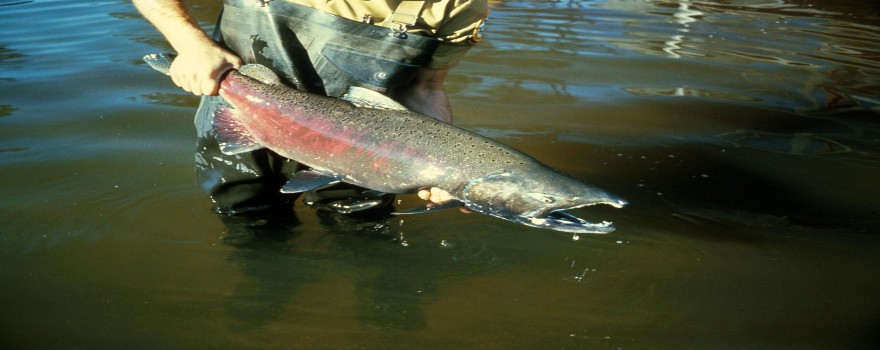
In science news this week: Chinook Salmon Flocking to Revitalized San Joaquin River; California power shutdowns raise air pollution worries; Our energy grid is vulnerable. Locally sourced power may be the answer; On the Northwest’s Snake River, the Case for Dam Removal Grows; Ancient Maya canals and fields show early and extensive impacts on tropical forests; Researchers map the evolutionary history of oaks; Liquid metals the secret ingredients to clean up environment; Meet The World’s 10 Coolest Bats; Taking care of carrion; Solar powered cars set off for Australia’s outback race; and more…
Chinook Salmon Flocking to Revitalized San Joaquin River “A staggering number of Chinook salmon are returning to a California river that hasn’t sustained salmon for decades due to agricultural and urban demands, giving biologists hope that threatened fish are finally spawning in their native grounds without human help.” Read more from Courthouse News here: Chinook Salmon Flocking to Revitalized San Joaquin River
California Wildfires: Lessons from Field Work in Baja California, Mexico “The 2017 and 2018 wildfire seasons in California were the most destructive on record raising a number of complex policy issues across a wide range of topics. I recently had the opportunity to learn about one of these major areas—forest management practices—firsthand by spending a week in Baja California, Mexico with UC Berkeley’s Dr. Scott Stephens and his research team.” Read more from California Council on Science and Technology here: California Wildfires: Lessons from Field Work in Baja California, Mexico
California power shutdowns raise air pollution worries “As utilities halted service to more than 2 million people this week, lines formed at hardware stores selling portable generators, while many hospitals and businesses fired up their own. The prospect of emissions belching from untold numbers of the machines, some powered by diesel and gasoline as well as propane and natural gas, was troubling in a state already burdened with some of the nation’s worst air quality.” Read more from Phys.org here: California power shutdowns raise air pollution worries
Our energy grid is vulnerable. Locally sourced power may be the answer “This week, the Pacific Gas and Electric Company took the unprecedented step of cutting power to nearly 750,000 Northern California customers, including much of the UC Berkeley campus, in an effort to mitigate the risk that active transmission lines could spark a wildfire during dry and windy conditions.” Read more from Berkeley News here: Our energy grid is vulnerable. Locally sourced power may be the answer
October 2019 ENSO update: fright night “There’s about an 85% chance the tropical Pacific will remain ENSO-neutral through the fall, and a 55-60% chance of continued neutral through the spring. We’ll talk about the current conditions and check in on the Atlantic hurricane season.” Read more from NOAA Climate here: October 2019 ENSO update: fright night
Salmon return to Oregon river by the hundreds to spawn after $2M restoration project “For the first time in nearly half of a century, fish experts have counted hundreds of spring Chinook salmon nests in the Lower South Fork McKenzie River in Blue River.” Read more from KATU.COM here: Salmon return to Oregon river by the hundreds to spawn after $2M restoration project
Liquid metals the secret ingredients to clean up environment “In a paper published today in Nature Communications, UNSW chemical engineers shone a light on the mysterious world of liquid metals and their role as catalysts to speed up chemical processes using low amounts of energy.” Read more from Science Daily here: Liquid metals the secret ingredients to clean up environment
On the Northwest’s Snake River, the Case for Dam Removal Grows “North America’s largest Pacific watershed, the Columbia River Basin, is in the midst of an environmental and energy crisis so severe that the most obvious, yet hotly contested, antidote — removal of four dams on the Columbia’s longest tributary, the Snake River — is gaining traction.” Read more from Yale Environment 360 here: On the Northwest’s Snake River, the Case for Dam Removal Grows
Weather time machine provides reconstruction of 1915 Galveston hurricane “West Coast fisheries ‘comeback of the century’ “With help from rebounding West Coast rockfish, Giuseppe “Joe” Pennisi has put the fisherman back in San Francisco’s famed Fisherman’s Wharf. Pennisi is the first fisherman to sell freshly caught fish off his boat at Fisherman’s Wharf in many years. He has reintroduced locals tIt’s been the stuff of science fiction for generations: a time machine that would allow researchers to reach back into yesteryear and ask new questions about long-ago events. This month, a NOAA-funded research team published an update to a weather “time machine” they’ve been developing since 2011.” Read more from NOAA Climate here: Weather time machine provides reconstruction of 1915 Galveston hurricane
Ancient Maya canals and fields show early and extensive impacts on tropical forests “New evidence in Belize shows the ancient Maya responded to population and environmental pressures by creating massive agricultural features in wetlands, potentially increasing atmospheric CO2 and methane through burn events and farming.” Read more from Science Daily here: Ancient Maya canals and fields show early and extensive impacts on tropical forests
Exploring and Protecting the Arkansas Bayou “Heavy rains seemed to wash away my plans for an Arkansas canoe trip, but Jeff Williams of Arkansas Wildlife magazine had another idea: Bayou DeView. This special place is not only an ideal place to explore by paddling, it also is the focus of extensive conservation efforts (and is rumored to hold one very famous bird).” Read more from Cool Green Science here: Exploring and Protecting the Arkansas Bayou
New tool visualizes nature’s benefits worldwide “Nature supports people in critical ways, often at a highly local level. Wild bees buzz through farms, pollinating vegetables as they go. Nearby, wetlands might remove chemicals from the farm’s runoff, protecting a community drinking water source.” Read more from Science Daily here: New tool visualizes nature’s benefits worldwide
Structural complexity in forests improves carbon capture “Forests in the eastern United States that are structurally complex — the arrangement of vegetation is varied throughout the physical space — sequester more carbon, according to a new study in Ecology, a journal of the Ecological Society of America.” Read more from the Ecological Society of America Here: Structural complexity in forests improves carbon capture
Why Keeping Mature Forests Intact Is Key to the Climate Fight “While Moomaw lauds intensifying efforts to plant billions of young trees, he says that preserving existing mature forests will have an even more profound effect on slowing global warming in the coming decades, since immature trees sequester far less CO2 than older ones. In an interview with Yale Environment 360, Moomaw explains the benefits of proforestation, discusses the policy changes that would lead to the preservation of existing forests, and sharply criticizes the recent trend of converting forests in the Southeastern U.S. to wood pellets that can be burned to produce electricity in Europe and elsewhere.” Read more from Yale Environment 360 here: Why Keeping Mature Forests Intact Is Key to the Climate Fight
Researchers map the evolutionary history of oaks “How oaks are related has long posed a challenge to scientists. Dr. Andrew Hipp, senior scientist at The Morton Arboretum, led an international team of 24 scientists to unravel the history of global oak diversity for the first time using DNA sequencing of 260 oak species, combined with genomic mapping and fossil data.” Read more from Phys.org here: Researchers map the evolutionary history of oaks
Burrowing birds create pockets of rich plant life in a desert landscape “In the rain-starved deserts of coastal Peru, tiny patches surprisingly rich in plant life dot the landscape. Burrowing birds may be responsible, scientists say.” Read more from Science News here: Burrowing birds create pockets of rich plant life in a desert landscape
New study shows coral reef fish do not mind 3-D-printed corals “Researchers across the globe are searching for ways to help endangered reefs, and the animals that live there, withstand or recover from weather events, including bleaching and storms that can occur with increasingly warmer water temperatures.” Read more from Phys.org here: New study shows coral reef fish do not mind 3-D-printed corals
Meet The World’s 10 Coolest Bats “For centuries, bats have been feared and persecuted. But attitudes change, and today conservationists recognize bats as incredibly cool creatures. For most of us, our bat encounters are likely to be fleeting as the little mammal flies by at dusk.” Read more from Cool Green Science here: Meet The World’s 10 Coolest Bats
Taking care of carrion “As a kid, I was first introduced to vultures through characters in the Jungle Book. Even though these cartoon vultures were kind of goofy, they were depicted against a gray, lifeless background. This seems to be a common theme in children’s movies: vultures typically symbolize death and foreboding.” Read more from Envirobites here: Taking care of carrion
More Opossums for the Internet “Opossums are having a bit of a moment thanks to the internet. America’s only marsupial – the Virginia opossum Didelphis virginiana — is what many consider unlovely. Gray fur and a bare, prehensile tail make it look rather rat-like. Beady eyes and a gaping mouth don’t help the image; their teeth look sharp, and they like to stand their ground. If all else fails, they “play possum,” looking for all the world like they’ve just gone and died.” Read more from Bay Nature here: More Opossums for the Internet
Solar powered cars set off for Australia’s outback race “More than 40 racing teams from 21 countries left Darwin on Sunday to race across Australia to the southern city of Adelaide in the world’s fastest solar powered cars.” Read more from Reuters here: Solar powered cars set off for Australia’s outback race
When it comes to teaching science, culture and language matter “Brown, a former high school science teacher, has studied science education in urban communities for more than two decades, exploring the relationship between student identity, classroom culture and academic achievement. For the past eight summers, Brown has brought fifth- and sixth-graders from inner-city schools to the Stanford campus for a weeklong science camp, where the students get excited about biology, physics, chemistry and engineering—and learn from teachers of color, who provide critical role models in the field.” Read more from Phys.org here: When it comes to teaching science, culture and language matter
Lisa’s XKCD Comic Pick of the Week …

 Sign up for daily email service and you’ll never miss a post!
Sign up for daily email service and you’ll never miss a post!
Sign up for daily emails and get all the Notebook’s aggregated and original water news content delivered to your email box by 9AM. Breaking news alerts, too. Sign me up!
About Science News and Reports: This weekly feature, posted every Thursday, is a collection of the latest scientific research and reports with a focus on relevant issues to the Delta and to California water, although other issues such as climate change are sometimes included. Do you have an item to be included here? Submissions of relevant research and other materials is welcome. Email Maven

